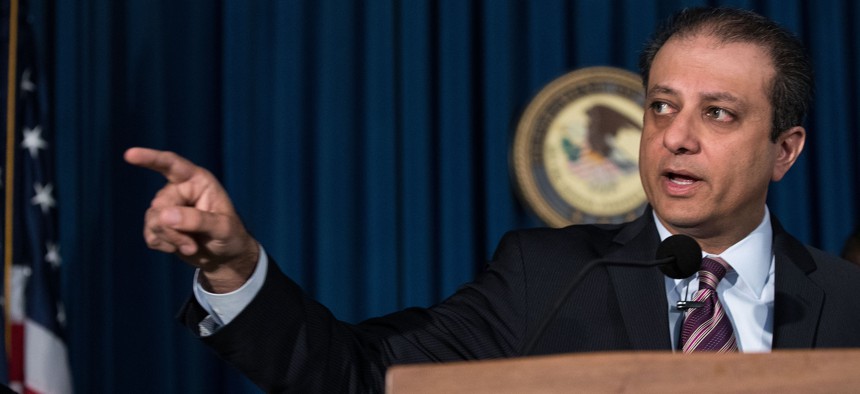The U.S. Attorney’s Office for the Southern District of New York has a reputation all its own among 93 U.S. attorney offices. It sees itself at the top of the ranks, and one former assistant U.S. attorney said there was a certain arrogance that came with working at SDNY. And that stellar reputation has been bolstered by exemplary leaders over the years. Here are a few of the recent U.S. attorneys who made a name for themselves and the office with their impressive record of prosecutions.
Robert Morgenthau (1961–1962, 1962–1970)
While Robert Morgenthau may be better known for his more than three decades leading the Manhattan district attorney’s office, he started his legal public service career at SDNY after being appointed by President John F. Kennedy. With U.S. Attorney General Robert F. Kennedy by his side, Morgenthau went after the Mafia, including Anthony Corallo of the Lucchese crime family in 1961-62 and a portion of the U.S. Senate’s McClellan Committee hearings on organized crime in the early ’60s. He also prosecuted the Quebec separatists who plotted to blow up the Statue of Liberty and took on white-collar criminals, like former Harvard Law School Dean James Landis.
Rudy Giuliani (1983–1989)
Rudy Giuliani, a notorious figure now, made a (positive) name for himself leading the office through most of the ’80s. His most notable achievements included the successful prosecution of Ivan Boesky on insider trading charges, Michael Milken on securities and mail fraud and several high-profile Mafia figures. He used the Racketeer Influenced and Corrupt Organizations Act to go after the heads of New York City’s “Five Families.” Anthony Salerno of the Genovese group, Anthony Corallo of the Lucchese group and Carmine Persico of the Colombo group were among the defendants convicted in 1986. Giuliani used his Mafia convictions and his tough on crime approach to win the New York City mayor’s race in 1993. However, his reputation has taken a significant hit since being involved with Donald Trump and facing bankruptcy.
Mary Jo White (1993–2002)
Mary Jo White made history as the first woman to lead the office when she was appointed by President Bill Clinton. Only a few months into her tenure, she took on the prosecution of the 1993 World Trade Center bombing suspects, ultimately convicting four men. She also got convictions in 1995 against Sheik Omar Abdel Rahman and nine others for a plot to destroy the United Nations building. She also indicted Osama bin Laden on terrorism conspiracy charges for bombings against American embassies in Africa. Beyond terrorism, White went after white-collar crimes like money laundering, fraud and a major cover-up at a Japanese bank as well as $600 million in restitution for defrauded clients of Republic Securities.
James Comey (2002–2003)
While then-President Donald Trump very publicly feuded with James Comey leading up to his firing as FBI director in 2017, Comey started in public service at SDNY in 1987. Serving as the U.S. attorney for two years, Comey prosecuted Martha Stewart for securities fraud in conjunction with her sale of ImClone Systems shares. He also pursued John Rigas, who was then the head of Adelphia Communications, and other executives for bank and securities fraud. He looked at Clinton’s pardons of Marc Rich and Pincus Green, but ultimately did not bring any charges.
Preet Bharara (2009–2017)
Preet Bharara became the first Indian American U.S. attorney, after being nominated by President Barack Obama in 2009. Bharara was well-known for prosecuting public corruption, terrorism, insider trading and white-collar crimes. He handled high-profile cases, including 2010 Times Square car bomber Faisal Shahzad. In 2012, Bharara was named by Time magazine as one of the world’s most influential people. Despite his successful record in fighting corruption, several of his cases have been overturned in recent years – most notably the 2015 case against then-Assembly Speaker Sheldon Silver. Silver was convicted on charges of wire fraud, extortion and mail fraud, but the ruling was overturned when the U.S. Supreme Court narrowed the definition of corruption. Silver was eventually convicted again and went to federal prison in 2020.
Silver was convicted on charges of wire fraud, extortion and mail fraud. However, the ruling was overturned due to the U.S. Supreme Court’s decision to narrow the definition of corruption, but Silver was convicted a second time and eventually went to federal prison in 2020.
NEXT STORY: This week’s biggest Winners & Losers


